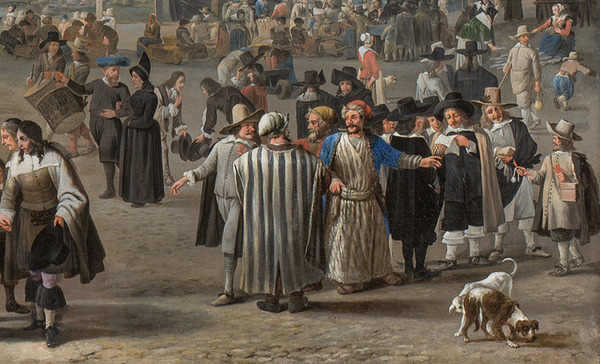The Early Armenian Merchant Community of Amsterdam
Armenians first arrived in the Low Countries in the twelfth century, with a small number of merchants settling in areas now part of Belgium and the Netherlands. However, it was not until the late sixteenth century that Armenians were first recorded in Amsterdam. By the seventeenth century, Amsterdam became a major economic hub and one of the most important port cities in the world. Armenian merchants, mostly middle-class traders from New Julfa, a suburb of Isfahan in Iran, were prominent among the city’s international traders. By the late seventeenth century, this small community, numbering fewer than one hundred people, was largely centered around the area of Nieuwmarkt in central Amsterdam.

Detail from the painting by Johannes Lingelbach The Dam, seen from the North, with the Town Hall under construction.
The non-Western persons at the right of the central group in this painting are interpreted as Armenians.
Armenian Printing House in Amsterdam and the First Armenian Bible
As Armenians were under Ottoman and Persian rulers during this time, independent book printing in Armenia had not been established. In turn, the first Armenian-language book, Urbatagirk or “Friday Book,” was printed and published in 1512 in Venice. After several Armenian printing houses had been established in Rome, Milan, and Paris by church representatives sent to Europe by the Catholicos in Etchmiadzin during the seventeenth century, the idea to start printing Armenian books in Amsterdam arose. Besides being a major trading center, Amsterdam, and the Netherlands more broadly, slowly replaced Italy as one of the leading places for printing during the seventeenth and eighteenth centuries. Aside from the technological developments, the Netherlands, as a Protestant majority country at that time, offered more freedom for the printing of ecclesiastical materials compared to Italy.
One of these ecclesiastical representatives was Mattheos Tsaretsi, who was sent to Europe by Catholicos Hakob IV in 1656 to establish a printing house and print the first Bible in Armenian. After an unsuccessful attempt in Italy, he arrived in Amsterdam. As part of a 1658 agreement, he commissioned 170 block punches and 240 matrices for small and large Armenian letters from Christoffel van Dyck, the renowned cutter at the Elzevir printing house. Additionally, Tsaretsi purchased woodcuts of Biblical scenes from Christoffel van Sichem. In 1660, Tsaretsi officially established one of the oldest printing houses in the world in Amsterdam and began printing the book Jesus, the Son, but died before he completed the work. His work was taken over by his companion, the merchant Avetis Yerevantsi (Ghlichents). As he needed to take care of both his commercial business and the printing house, he invited his brother Voskan, bishop of Goght’n and abbot of Saint Sargis Monastery, to assist with the printing endeavors. After his arrival in the Netherlands in 1664, the brothers improved and completed the set of letters initially bought by Tsaretsi, and Voskan soon after secured financial resources for future printing work from a network of Armenian merchants.
In 1666, after printing several smaller works, including a hymn book, Voskan Yerevantsi, assisted by a couple of younger companions, began printing the work that brought him to Amsterdam – the first Armenian-language Bible. The printing was finalized on October 13, 1668. Its text is based on a 1295 manuscript for Armenian King Hetum II of Cilicia. The first edition of the Bible, measuring 21 x 26 cm, contained approximately 1,470 pages and 159 images. Many sections of the text were printed in decorative letters shaped like birds, rabbits, and other animals. Additionally, the woodcuts by Christoffel van Sichem, previously used in the 1657 Roman Catholic Biblia Sacra, served as rich illustrations in the book. The Amsterdam Bible in Armenian was published in 5000 copies.
From 1664 to 1669, Yerevantsi printed eighteen ecclesiastical and secular books in his fully equipped printing house. Due to financial difficulties, the printing house soon shut down before opening again in 1685 and later operated intermittently until 1718. Most materials, both religious and secular books, published by the Armenian printing house in Amsterdam were exported to Turkey and Iran and thus strengthened the transnational connections among the dispersed members of the Armenian community. The Armenian Bible has been published in ten editions since its original version in 1666, with the most recent edition printed in Vienna by the Mekhitarist Fathers in 1929.
The establishment of the Armenian printing house in Amsterdam during the seventeenth century, culminating in the first printing of the Bible in the Armenian language, laid a crucial foundation for the future of Armenian ecclesiastical printing. This achievement not only strengthened the Armenian Church’s literary tradition but also left a lasting impact on the transnational Armenian community of that era and future generations. As a result, Amsterdam holds a unique and significant place in the history of Armenian printing and literature.
The copies of the 1666 Armenian Bible and of other materials from the Armenian printing firm in Amsterdam can be found in the library collections of the universities of Amsterdam and Leiden, as well as in Surp Hoki Armenian Apostolic Church in Amsterdam.
Catholicos
In the Armenian Church, the term catholicos originally referred to the principal bishop of the country and later extended to metropolitans who held authority over other bishops. Today, it designates the leader of the Armenian Apostolic Church. There are currently two catholicoi in the Armenian Church: one resides in Etchmiadzin, Armenia, and the other in Antelias, Lebanon.
Matija Miličić
Researcher and Heritage Specialist Eastern and Oriental Christianity Museum Catharijneconvent
Last edited
October 24, 2024
The Dam, seen from the North, with the Town Hall under construction, Johannes Lingelbach, 1656. Collection Amsterdam Museum.
Aslanian, S. D., Early Modernity and Mobility: Port Cities and Printers across the Armenian Diaspora, 1512-1800 (Yale University Press 2023).
Nersessian, V., The Bible in the Armenian Tradition (J. Paul Getty Museum 2001).
Schütz, O., ‘Nicholas Misztótfalusi Kis and the Armenian Book Printing’ in: Acta Orientalia Academiae Scientiarum Hungaricae 9, no. 1 (1959) 63-73.




